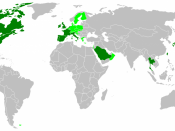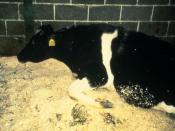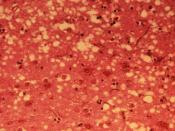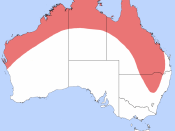QUESTION- Australia has always had very strict quarantine rules for the import of plant and animal substances to protect both primary industry and native species. In recent years there has been an increasing economic push to permit the entry of more plant and animal substances from overseas. Argue the case for or against the entry of more plant and animal substances in relation to its impact on at least one of the following:ÃÂThe Environment- (pests already introduced into Australia)ÃÂTrade- (International goods)ÃÂPrimary Industry- (Agriculture)Introduction:-Australia has always had very strict quarantine rules for the import of plant and animal substances to protect both primary industry and native species. In recent years there has been an increasing economic push to permit the entry of more plant and animal substances from overseas. However the introduction of foreign plants and animal substances threatens to destroy the environment we Australians have worked so hard to maintain with our strict quarantine laws.
AustraliaÃÂs enjoys a great reputation as an exporter of high-quality, clean agricultural produce and that depends largely on its freedom from exotic pests and diseases. The introduction of exotic pests and diseases could have grave environmental and economic consequences for Australia. It has been estimated that a major outbreak of foot-and-mouth disease could cost Australia as much as $13 billion. This essay will critically discuss and examine how the Australian environment and the Primary Industry factors are affected by foreign threats.
AustraliaÃÂs agricultural industries are of paramount significance as they make up a fifth of AustraliaÃÂs national economy. The Australian Department of Agriculture, Fisheries and Forestry and AQIS are working hard and targeting to reduce the risk to AustraliaÃÂs agricultural industries from a range of exotic diseases and pests, that can come from overseas if strict quarantine laws are not implemented. Some of these exotic diseases and pests include:ÃÂKhapra beetleÃÂthe worldÃÂs most serious pest of stored grains. Quarantine rules make sure that Australia is kept free of this pest because, if this pest became established in Australia it would pose a major threat to export trade worth billions of dollars.
ÃÂGiant African snailÃÂknown to attack at least 500 species of plants. AustraliaÃÂs quarantine laws aim at stopping this pest from coming into Australia as it could even threaten AustraliaÃÂs eucalypts as well as cocoa, peanut and legume crops.
ÃÂAsian gypsy mothÃÂa threat to more than 600 species of native, fruit and ornamental trees.
ÃÂKarnal buntÃÂa fungal disease. Australian quarantine laws are vigilant about stopping this ever being introduced to Australia because it can ruin wheat and would be a threat to exports worth billions of dollars.
Australia is presently free of pest diseases. The worst ones are diseases such as rabies and mad cow disease (Bovine Spongiform encephalopathy). Rabies is a fatal viral disease of warm-blooded animals, including humans. It is usually spread by the bite of an infected animal such as a dog, cat, bat or fox. This disease has not reached Australia, but it has been reported in most parts of the world. Between 40,000 and 70,000 people die of rabies worldwide each year, with at least 10 million receiving treatment after being exposed to wild animals suspected of having rabies. This makes sense when it is said that humans are usually infected with rabies when the saliva of a wild animal enters the body via an old wound or a bite. According to DAFF (Department of Agriculture, Fisheries and Forestry), if rabies was introduced and spread into Australia, it ÃÂcould profoundly change our way of life and the disease would be very difficult to eradicate if it became established in dogs and cats or native wildlife. People could never feel safe when approaching a stray cat or dog. All imported animals are subject to strict quarantine requirements, including vaccination for dogs and cats from all affected countriesÃÂ.
Bovine Spongiform Encephalopathy (BSE or Mad Cow Disease) is a fatal, neurodegenerative disease in cattle,that causes a spongy degeneration in the brain and spinal cord, caused by the protein agent ÃÂprionÃÂ. According to the World Organisation for Animal Health (OIE), they claim that certain cattle tissues present a risk of transmitting BSE and recommends that these be removed from cattle from BSE affected countries at slaughter if they are above a certain age. These tissues are tonsils, part of the small intestine, brains, eyes, spinal cord, skull and vertebral column. Even though BSE hasnÃÂt come to Australia yet, it is feared that the disease could come from animals imported from BSE infected countries, or that the feedstuff may be mixed with the BSE, or that imported biological agents may have been contaminated with the BSE agent.
However, it may be very difficult to eradicate a pest that has already been in the country for years, ironically, in some cases brought in to remove other irritating and deadly pests. The cane toad is probably one of AustraliaÃÂs more recent pest problems. The cane toad was introduced to Australia from Hawaii in the early 1930s to combat the pests in the Queensland cane fields. Since then it has been a big destroyer of fauna and flora and has exponentially spread into the Northern Territory and New South Wales. Another pest problem is the European Rabbit, originated from Europe and introduced to Australia in 1788 as a source of recreational hunting. Today, 221 years from now, it has an estimated population in excess of at least 200 million. Even though they are not considered as feral, they are known to ravage and destroy the land. Also, another pest is the Red Fox, also brought out from Europe to Australia for recreational hunting, this time in 1871. Today, it has a population approximately numbering in excess of 7.2 million. Currently, it is a prolific and ÃÂunapproachableÃÂ hunter of livestock and stray animals.
According to DAFF, ÃÂAustralia has a favourable plant health status, being free from many of the damaging plant pests that occur overseas. This is a key factor in determining the success of AustraliaÃÂs plant industries. It provides these industries with a competitive advantage in terms of trade in plant and plant products, helping them to maintain and gain access to new domestic and international markets. AustraliaÃÂs plant industries ÃÂ including horticulture, grains and forestry ÃÂ are largely dependent on trade to remain profitable and sustainableÃÂ. DAFF also gives some simple, healthy advice for those who handle gardening and planting. They say that things like simple hygiene skills washing your hands after gardening and cleaning used farming equipment can go a long way in protecting oneÃÂs backyard plants from pests and diseases.
The following is a quote that sums up the entire message of the essay:-ÃÂFood, plant material and animal products from overseas - including many common souvenirs ÃÂ could introduce some of the world's most serious pests and diseases into Australia, devastating our valuable agriculture and tourism industries and unique environmentÃÂ- DAFF. This quote emphasises the reasons as to why Quarantine laws are of paramount importance to our flora and fauna. Also, it attempts to explain to tourists that some harmless, common foreign souvenir could potentially present major disease and pest problems. These diseases and pests will be hard to eradicate when it comes and stays.
RebuttalHowever, it has been acknowledged, argued and proven that foreign imports such as electric and electronic goods, machines, vehicles, fuel and oil is much needed for Australia. We can see that these products are man-made and wonÃÂt cause pest problems and diseases like mad cow disease and rabies; problems caused by foreign/imported animals and plants. We need these man-made, electronic items, as part of our ÃÂhigh techÃÂ lifestyles, as they are greatly needed in the technologically advanced world that we live in todayÃÂs post World War 2 contemporary society.
ConclusionIn conclusion, it has been demonstrated that foreign plants and animals pose a serious threat to Australian-bred fauna and flora. This essay focused on the Primary Industry aspect within the Australian Quarantine and Inspection Service rules and regulations. While other countries suffer from these ÃÂoften fatalÃÂ pest diseases for because of lax quarantine laws, Australia always maintains a high regard for the risks of bringing foreign natural products. Australia has always had strict quarantine laws for imported animals and plants, and that is why this country is not suffering and overrun with dangerous pest diseases like most other countries.
Bibliography:Cox, David, S. Quarantine and the whyÃÂs Sydney Uni Press, 2004www.daff.gov.au/aquis/compliance-investigations/laws-rolewww.dfat.gov.au/facts/quarantine.html





